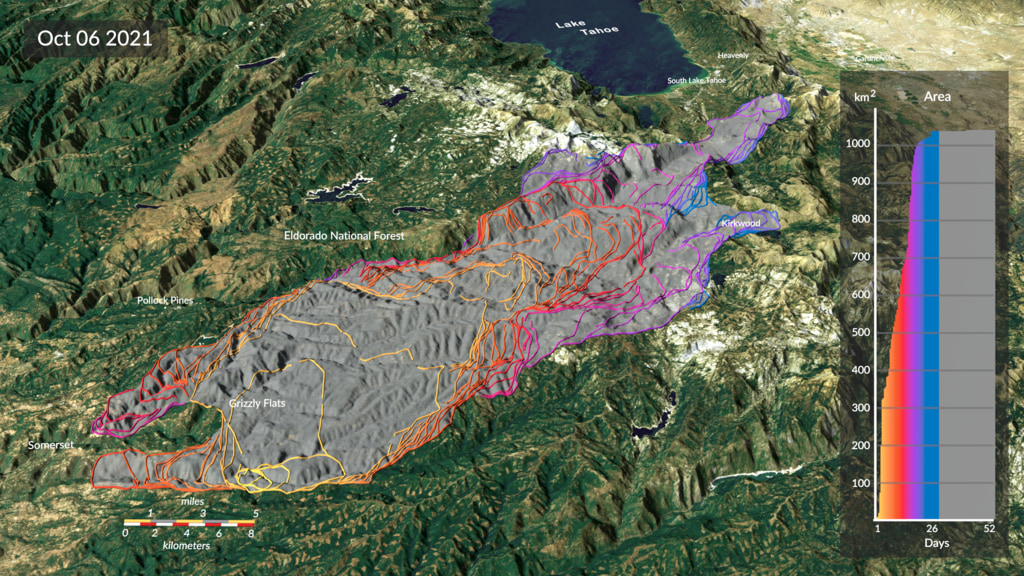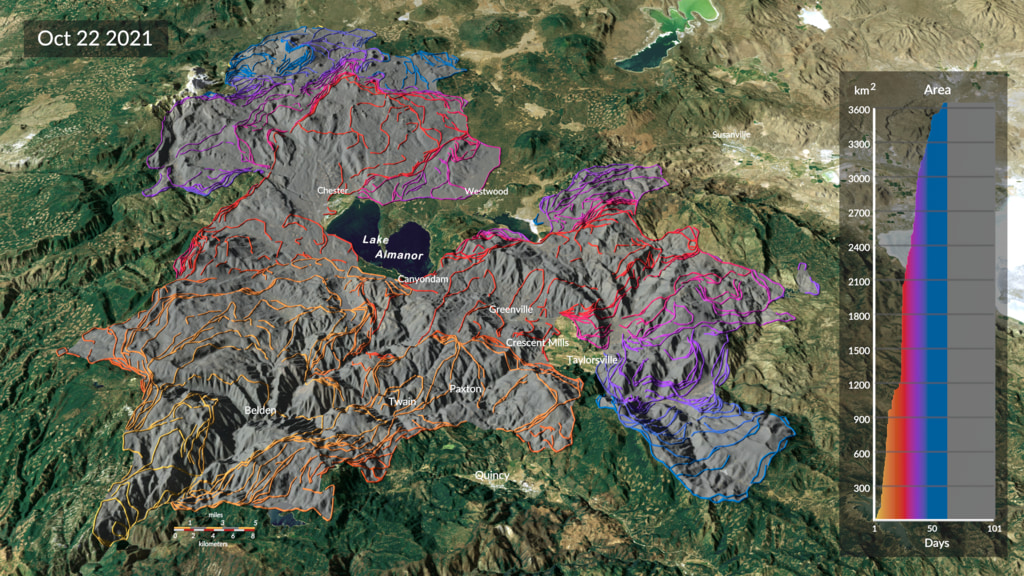Tracking the Spread of the Caldor and Dixie Fires
This visualization shows the spread of the Caldor and the Dixie fires in California during the summer of 2021, updated every 12 hours from a new fire detection and tracking approach based on near-real time active fire detections from the VIIRS sensor on the Suomi-NPP satellite.
Complete transcript available.
This visualization highlights data from a new fire detection and tracking approach (Chen et al., 2022) based on near-real time active fire detections from the VIIRS sensor on the Suomi-NPP satellite. Every 12 hours, the fire tracking algorithm uses new active fire detections to update the total fire perimeter and estimate the position of active fire lines where the fire may continue to spread. This approach provides a detailed perspective on the behavior of the Caldor and Dixie fires, identifying periods of rapid fire expansion and active fire detections within the perimeter from continued flaming and smoldering behind the active fire fronts.
The visualization shows the progression over time as the fire spreads. The yellow outlines track the position of the active fire lines every 12 hours for the last 60 hours, with the latest location of the fire front shown in the brightest shade of yellow. The red points show the location of active fire detections within the perimeter, while the grey region shows the estimated total area burned. The graph shows the cumulative burned area in square kilometers.

This image shows the extent of the Caldor fire on August 21, 2021. The yellow outlines track the position of the active fire lines for the last 60 hours, with the latest location of the fire front in the brightest shade of yellow. The red points show the location of active fire detections, while the grey region shows the estimated total area burned. The graph shows the cumulative burned area in square kilometers.

This image shows the spread of the Caldor fire between August 15 and October 6, 2021, with the fire line for each 12-hour time step shown in a different color.

This image shows the extent of the Dixie fire on July 31, 2021. The yellow outlines track the position of the active fire lines for the last 60 hours, with the latest location of the fire front in the brightest shade of yellow. The red points show the location of active fire detections, while the grey region shows the estimated total area burned. The graph shows the cumulative burned area in square kilometers.

This image shows the spread of the Dixie fire between July 14 and October 22, 2021, with the fire line for each 12-hour step in time shown in a different color.

Perimeters of Dixie and Caldor wildfires located in California. The extent of the Dixie wildfire is as of October 22, 2021, while the extent of the Caldor wildfire is as of October 6, 2021. The dropdown menu offers multiple resolutions for a 16:9 aspect ratio.
Credits
Please give credit for this item to:
NASA's Scientific Visualization Studio
-
Technical support
- Ian Jones (ADNET Systems, Inc.)
- Laurence Schuler (ADNET Systems, Inc.)
-
Visualizers
- Kel Elkins (USRA)
- Michala Garrison (SSAI)
- Greg Shirah (NASA/GSFC)
- Horace Mitchell (NASA/GSFC)
- Andrew J Christensen (SSAI)
- Alex Kekesi (Global Science and Technology, Inc.)
- Cindy Starr (Global Science and Technology, Inc.)
-
Scientist
- Doug C. Morton (NASA/GSFC)
Release date
This page was originally published on Monday, June 12, 2023.
This page was last updated on Wednesday, November 15, 2023 at 12:20 AM EST.
Series
This visualization can be found in the following series:Papers used in this visualization
Chen, Y., Hantson, S., Andela, N. et al. California wildfire spread derived using VIIRS satellite observations and an object-based tracking system. Sci Data 9, 249 (2022). https://doi.org/10.1038/s41597-022-01343-0
Datasets used in this visualization
-
DEM [SRTM: SIR-C]
ID: 481 -
Band Combination 4-3-2 [Landsat-8: OLI/TIRS]
ID: 1086 -
California Wildfire Spread Derived using VIIRS Observations and an Object-based Tracking System (California Wildfire Spread Derived using VIIRS Observations and an Object-based Tracking System) [Suomi-NPP: VIIRS]
ID: 1178Credit: Chen, Yang; Hantson, Stijn; Andela, Niels; Coffield, Shane; Graff, Casey; Morton, Douglas C.; et al. (2022): A Dataset of California Wildfire Spread Derived Using VIIRS Observations and an Object-based Tracking System. figshare. Collection. https://doi.org/10.6084/m9.figshare.c.5601537.v1
This dataset can be found at: https://springernature.figshare.com/collections/A_Dataset_of_California_Wildfire_Spread_Derived_Using_VIIRS_Observations_and_an_Object-based_Tracking_System/5601537/1
See all pages that use this dataset
Note: While we identify the data sets used in these visualizations, we do not store any further details, nor the data sets themselves on our site.


